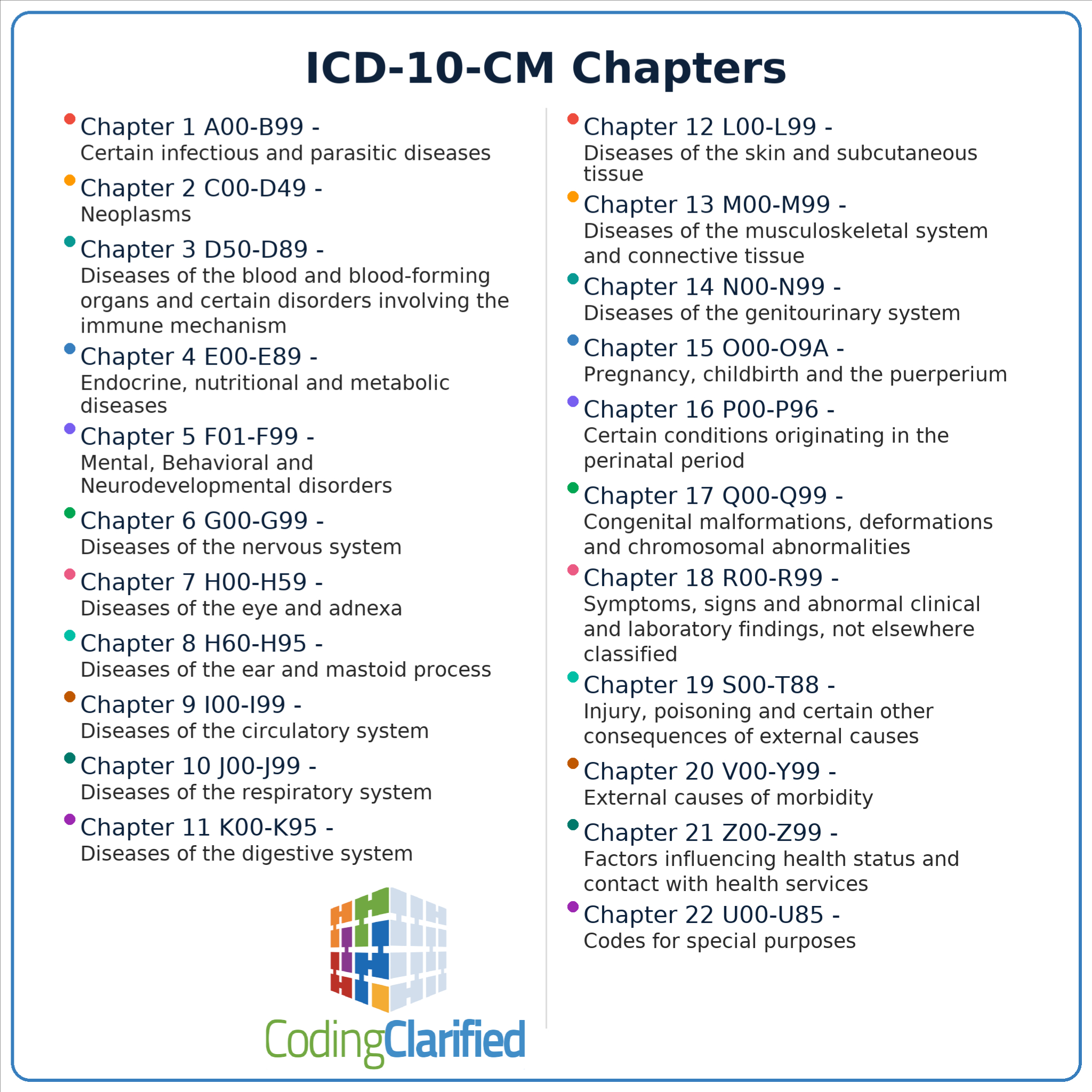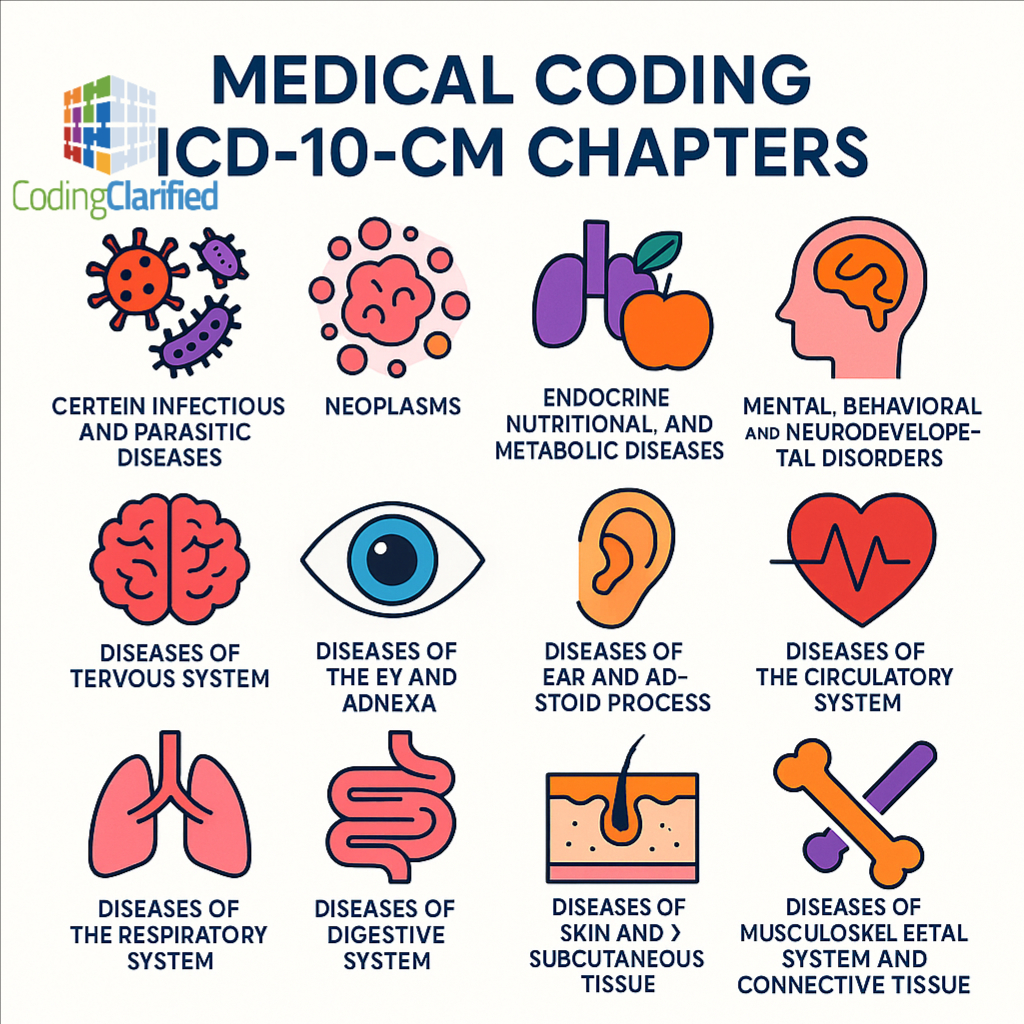ICD-10-CM Chapters: What’s Included, Guidance, and Coding Tips
The medical coding ICD-10-CM chapters manual is organized into 21 chapters, each covering a specific range of codes tied to body systems, conditions, or circumstances. Understanding what belongs in each chapter—and the rules that apply—helps coders assign the most accurate codes, pass certification exams, and avoid denials.
Chapter 1: A00–B99 – Certain Infectious and Parasitic Diseases
-
Includes: Bacterial, viral, parasitic, protozoal, helminthic infections; sepsis; HIV; TB; Zika; COVID-19.
-
Guidance: Many codes here require additional coding for the organism (e.g., bacterial agent) or manifestations (e.g., pneumonia due to influenza).
-
Tip: Always check if the condition requires a combination code (like HIV with related illness) vs. multiple codes.
Chapter 2: C00–D49 – Neoplasms
-
Includes: Malignant, benign, in situ, and uncertain behavior tumors.
-
Guidance: Use the Neoplasm Table in the Alphabetic Index; pay attention to primary vs. secondary (metastatic) sites.
-
Tip: Always code the primary site first, then the secondary. Use “history of” codes (Z85–) when cancer is resolved but documented as history.
Chapter 3: D50–D89 – Diseases of the Blood and Blood-Forming Organs, and Certain Disorders of the Immune Mechanism
-
Includes: Anemias, coagulation defects, hemophilia, leukemias, and immune deficiencies.
-
Guidance: Look for causative factors (iron deficiency, chronic disease, anemia).
-
Tip: Link anemia to underlying conditions whenever possible.
Chapter 4: E00–E89 – Endocrine, Nutritional, and Metabolic Diseases
-
Includes: Diabetes, thyroid disorders, malnutrition, metabolic disorders.
-
Guidance: Diabetes codes (E08–E13) require specificity (cause, complications, control).
-
Tip: Always confirm Type 1 vs. Type 2 diabetes and whether complications are present.
Chapter 5: F01–F99 – Mental, Behavioral, and Neurodevelopmental Disorders
-
Includes: Depression, schizophrenia, dementia, anxiety, and substance-related disorders.
-
Guidance: Mental health coding requires documentation of type, severity, and recurrence.
-
Tip: For substance abuse, differentiate between use, abuse, and dependence.
Chapter 6: G00–G99 – Diseases of the Nervous System
-
Includes: Epilepsy, migraines, multiple sclerosis, Parkinson’s disease.
-
Guidance: Pay attention to laterality (left vs. right) for neurologic conditions.
-
Tip: Many neurological conditions require secondary coding for associated symptoms (e.g., seizures).
Chapter 7: H00–H59 – Diseases of the Eye and Adnexa
-
Includes: Glaucoma, cataracts, retinal disorders, and conjunctivitis.
-
Guidance: Laterality (right, left, bilateral) is critical.
-
Tip: For glaucoma, identify the type and stage.
Chapter 8: H60–H95 – Diseases of the Ear and Mastoid Process
-
Includes: Otitis media, hearing loss, vertigo, mastoiditis.
-
Guidance: Laterality applies here, too.
-
Tip: Acute vs. chronic otitis media coding is exam favorite.
Chapter 9: I00–I99 – Diseases of the Circulatory System
-
Includes: Hypertension, heart disease, stroke, and peripheral vascular disease.
-
Guidance: Code hypertension with heart/kidney disease using combination codes.
-
Tip: Sequence acute MI before history codes when coding encounters.
Chapter 10: J00–J99 – Diseases of the Respiratory System
-
Includes: Pneumonia, asthma, COPD, and influenza.
-
Guidance: Identify the causal organism for pneumonia; combination codes are common.
-
Tip: For asthma, note if intermittent, persistent, or exacerbated.
Chapter 11: K00–K95 – Diseases of the Digestive System
-
Includes: GERD, ulcers, Crohn’s, hernias, liver disease.
-
Guidance: Differentiate Crohn’s vs. ulcerative colitis; cirrhosis requires cause coding (alcoholic, viral).
-
Tip: Look for links to alcohol use or viral hepatitis.
Chapter 12: L00–L99 – Diseases of the Skin and Subcutaneous Tissue
-
Includes: Dermatitis, cellulitis, psoriasis, burns, and pressure ulcers.
-
Guidance: Burns and pressure ulcers require location and severity/stage.
-
Tip: For pressure ulcers, code site + stage (always both).
\Chapter 13: M00–M99 – Diseases of the Musculoskeletal System and Connective Tissue
-
Includes: Arthritis, fractures, osteoporosis, and back pain.
-
Guidance: Use the 7th character for fracture aftercare (A = initial, D = subsequent, S = sequela).
-
Tip: Document laterality and episode of care.
Chapter 14: N00–N99 – Diseases of the Genitourinary System
-
Includes: Kidney disease, urinary infections, prostate disorders, and infertility.
-
Guidance: CKD stages (N18.1–N18.6) are critical.
-
Tip: Link CKD with hypertension when documented.
Chapter 15: O00–O9A – Pregnancy, Childbirth, and the Puerperium
-
Includes: Pregnancy complications, delivery, and postpartum issues.
-
Guidance: The code is from the mother’s record, not the infant’s. Always assign a week of gestation code.
-
Tip: Use the O code first, then secondary condition codes.
Medical Coding Pregnancy and Childbirth
Chapter 16: P00–P96 – Certain Conditions Originating in the Perinatal Period
-
Includes: Disorders in newborns (low birth weight, jaundice, birth injuries).
-
Guidance: Only used for the infant’s record.
-
Tip: Differentiate birth injury vs. congenital anomaly.
Chapter 17: Q00–Q99 – Congenital Malformations, Deformations, and Chromosomal Abnormalities
-
Includes: Down syndrome, cleft palate, and congenital heart defects.
-
Guidance: Code congenital anomalies as long-term conditions.
-
Tip: These remain coded even in adulthood.
Chapter 18: R00–R99 – Symptoms, Signs, and Abnormal Clinical and Laboratory Findings
-
Includes: Chest pain, fever, abnormal labs, coma.
-
Guidance: Only code symptoms when no definitive diagnosis is made.
-
Tip: In inpatient coding, symptoms are rarely principal unless no diagnosis is confirmed.
Medical Coding Signs & Symptoms in Diseases and Medical Coding Labs
Chapter 19: S00–T88 – Injury, Poisoning, and Certain Other Consequences of External Causes
-
Includes: Injuries, fractures, burns, poisonings, complications.
-
Guidance: Use the 7th character to identify encounter type (initial, subsequent, sequela).
-
Tip: Always code external cause codes (Chapter 20) with these.
Medical Coding From the ICD-10-CM Table of Drugs And Chemicals
Chapter 20: V00–Y99 – External Causes of Morbidity
-
Includes: Accidents, assaults, and environmental events.
-
Guidance: Never used alone; they explain how an injury occurred.
-
Tip: Assign as secondary codes to injury/poisoning.
Chapter 21: Z00–Z99 – Factors Influencing Health Status and Contact with Health Services
-
Includes: Encounters for screenings, immunizations, history, and follow-ups.
-
Guidance: Use when the patient does not have a current illness but needs services.
-
Tip: Common on exams (e.g., “encounter for colonoscopy screening”).
Final Tips for Coders
-
Always use the Alphabetic Index first, then verify in the Tabular List.
-
Watch for Excludes1/Excludes2 notes in each chapter—they prevent coding errors.
-
Pay attention to laterality, specificity, and 7th characters.
-
Sequence codes correctly (e.g., principal diagnosis first).
-
Remember: Documentation drives coding—never assume.


